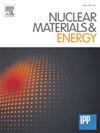预锂化样品中的氘保留和DIII-D托卡马克中Li-D共沉积
IF 2.7
2区 物理与天体物理
Q1 NUCLEAR SCIENCE & TECHNOLOGY
引用次数: 0
摘要
包括液态锂的分流器设计已被提出作为固体设计和壁面调节技术的替代方案。然而,锂与氚的亲和力对燃料循环构成了风险。本研究研究了预锂化样品和DIII-D托卡马克中Li -d共沉积中的氘保留,首次直接比较了Li -d共沉积和预沉积Li薄膜。将样品暴露在远刮层(SOL)的h模等离子体中,用杂质粉末滴管原位注入Li粉末,研究Li涂层的均匀性,以及燃料保留量与Li厚度的关系。结果表明,在低于锂熔点的温度下,氘的保留与预沉积锂层的厚度无关,锂-d共沉积是燃料保留的主要因素。预沉积和原位沉积的锂都比溅射产率计算预测的要低。这些结果表明,在导流器中使用锂的聚变反应堆中,燃料滞留很可能是由共沉积而不是导流器本身主导的。如果人们希望使用锂来获得更平坦的温度分布,至少在低于锂熔点的温度下,操作式锂注入比预沉积的锂膜更有利。本文章由计算机程序翻译,如有差异,请以英文原文为准。
Deuterium retention in pre-lithiated samples and Li–D co-deposits in the DIII-D tokamak
Divertor designs involving liquid lithium have been proposed as an alternative to solid designs and wall conditioning techniques. However, Li affinity with tritium poses a risk for the fuel cycle. This study investigates deuterium retention in pre-lithiated samples and Li–D co-deposits in the DIII-D tokamak, making for the first time a direct comparison between Li–D co-deposits and pre-deposited Li films. Samples were exposed to H-mode plasmas in the far scrape-off layer (SOL), and Li powder was injected in-situ with the impurity powder dropper to study the uniformity of Li coatings, and the dependence of fuel retention on Li thickness. The results show that at temperatures below the melting point of lithium, deuterium retention is independent of the thickness of pre-deposited Li layers, with Li–D co-deposits being the primary factor for fuel retention. Both pre-deposited and in-situ deposited Li showed lower erosion than predicted by sputtering yield calculations. These results suggest that fuel retention in fusion reactors using lithium in the divertor will likely be dominated by co-deposits rather than in the divertor itself. If one desires to use Li to achieve flatter temperature profiles, operando Li injection is advantageous over pre-deposited Li films, at least at temperatures below the melting point of lithium.
求助全文
通过发布文献求助,成功后即可免费获取论文全文。
去求助
来源期刊

Nuclear Materials and Energy
Materials Science-Materials Science (miscellaneous)
CiteScore
3.70
自引率
15.40%
发文量
175
审稿时长
20 weeks
期刊介绍:
The open-access journal Nuclear Materials and Energy is devoted to the growing field of research for material application in the production of nuclear energy. Nuclear Materials and Energy publishes original research articles of up to 6 pages in length.
 求助内容:
求助内容: 应助结果提醒方式:
应助结果提醒方式:


